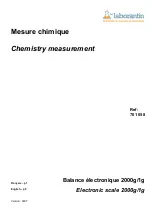
Page 12
Instruction manual 55034XXX Version 1 March-04
1. APPLICATIONS
2. DESCRIPTION
The Nahita analytical balance is an essential instrument in laboratory work when weig-
hing tasks need to be carried out. It is a reliable and long-lasting instrument, which has been
developed with the latest technology. Its simple, sturdy, ergonomic design makes this balan-
ce suitable for any industrial use, and its smooth surface makes the cleaning easier.
ELECT
RONIC
BALAN
CE
MODEL
5034/60
60
gr / 0.1
mg
g
1
2
3
4
AC220V
OPTION
0.5A
GND EXT TARE
AUTO PRINT
DISP RATE
STAB SYM
AV TIME
CAL WEIGHT
BAND WIDTH
C7022
6
7
ELECTRONIC BALANCE
MODEL 5034/60
60 g/0.1 mg
1
2
3
4
5
Picture 1
Picture 2 - Front panel
Picture 3 - Rear panel
1.1. Front panel
1.2. Level
1.3. Plate
1.4. Glass windbreak protection
2.1. ON/OFF
2.2. Print (out of use)
2.3. Tare
2.4. Calibration
2.5. Digital screen
3.6. Plug socket
3.7. Fuse
Version 1 March-04
Instruction manual 55034XXX Page 17
Open the port by removing the plug and you will find the underhook.
Hang a fine thread through the hole.
Place the balance on a table with a hole in it or a stand specially designed for below
weighing, and let the thread through the hole
Suspend a plate. For best results it is necessary to recalibrate the balance, erasing the
information on the screen and you will see
0, 00000 g
.
Density determination
Place the material with an unknown density in the plate when value
0, 00000 g
is shown
on the screen.
Read the value of the material's weight suspended in the air.
Press
Tare
key in order to put zero on the display.
Immerse the container (with a known value now) in the water at 10ºC.
Read out the difference of weights between the weight of the material in air and the
weight of the material in water.
Calculate the density of the water density from the following board:
Calculate the density of the material:
Weight in air (g) ÷ water density (cm
3
) =g/cm
3
0ºC
0,99984 g/cm
3
4ºC
0,99997 g/cm
3
10ºC
0,99970 g/cm
3
15ºC
0,99910 g/cm
3
20ºC
0,99821 g/cm
3
25ºC
0,99705 g/cm
3
30ºC
0,99565 g/cm
3
6. MAINTENANCE AND CLEANING
To get the best results and a higher duration of this equipment it is necessary to follow
the processes of use.
Note:
All the processes of use mentioned before will not have any value unless you keep
a continued and careful maintenance.
General recommendations
Please follow the processes of use of this manual.
This manual should be available for all users of these equipments.
Always use original components and supplies. Other dispositives can be similar but
they can damage the equipment.
Preserve the balance from heavy shocks and look for a dry place, away from dust, direct
sun beams or air flows. Handle the balance gently, since it is an accurate instrument.
ENGLISH
ENGLISH
































